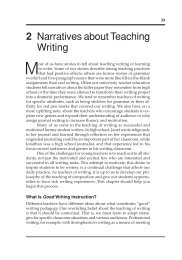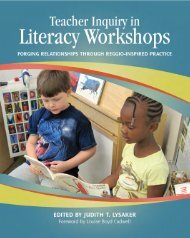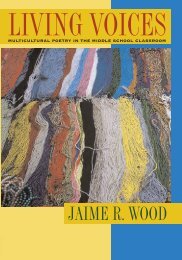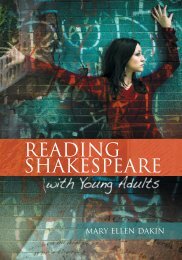Graphic novel Spread - National Council of Teachers of English
Graphic novel Spread - National Council of Teachers of English
Graphic novel Spread - National Council of Teachers of English
- No tags were found...
You also want an ePaper? Increase the reach of your titles
YUMPU automatically turns print PDFs into web optimized ePapers that Google loves.
14 James Bucky Carter<br />
editor’s prerogative for a moment and go even further. Allow me, if you<br />
will, to tell you the role that comic books and graphic <strong>novel</strong>s have played<br />
in my own development as a child, as an adult, and as a teacher.<br />
I have been reading comics since I could read anything. My teenage<br />
mother read them to me before I was literate because, I imagine,<br />
they were cheap and we were poor and because, as a high school dropout,<br />
she was probably sick <strong>of</strong> the more traditional texts she once confronted<br />
in school. To this day most <strong>of</strong> her own reading consists <strong>of</strong> the<br />
chance <strong>novel</strong>, the Bible, and an occasional magazine, although she has<br />
rediscovered joy in the act <strong>of</strong> reading, and her efforts with comics certainly<br />
helped instill in me a love and appreciation <strong>of</strong> art and literature<br />
that has yielded degrees in both disciplines and a strong desire to see<br />
them shared with everyone. My first teaching job, in 1999, was at a high<br />
school in a suburb <strong>of</strong> Charlotte, North Carolina, and my toughest assignment<br />
was to take a group <strong>of</strong> remedial readers in a grades 9–12 combination<br />
class and mold them into at least partially motivated literates<br />
capable <strong>of</strong> enjoying written work—and passing North Carolina’s “gateway”<br />
reading test, which they had taken unsuccessfully for the first time<br />
in grade 8. The class was a snapshot <strong>of</strong> typically difficult-to-teach students:<br />
504 plans, IEPs, poverty, drug and gang issues, family and personal<br />
traumas (including homelessness and stabbings) made up their<br />
day-to-day existence.<br />
Since I was short on supplies to begin with, I was eager to augment<br />
my curriculum, and I turned to comics for help. After getting a<br />
local vendor to donate more than $200 worth <strong>of</strong> comics, I began to incorporate<br />
them into our everyday lessons. For example, when we read<br />
Rodman Philbrick’s Freak the Mighty, I first used comics as complements<br />
to the classics, reinforcing the difficult concept <strong>of</strong> symbiotic relationships<br />
and interdependency by pairing the text with a Spider-Man comic in<br />
which Spidey fights Venom and Carnage, two alien villains who bond<br />
to human hosts, thereby creating symbiotic relationships. The contrast<br />
is, <strong>of</strong> course, that Philbrick’s characters share a fairly healthy interdependency,<br />
whereas poor Peter Parker experiences the direct badness that<br />
symbiotic or co-dependent relationships can entail (see Figure 1.1).<br />
The classroom conversations on good and bad relationships were<br />
poignant, in no small part due to the students’ ability to connect to the<br />
themes and because <strong>of</strong> the immediate connection to popular culture via<br />
comics (remember Morrison, Bryan, & Chilcoat, 2002).<br />
I integrated comics again later in the semester as it became more<br />
apparent to me that a lack <strong>of</strong> role models and a poor sense <strong>of</strong> connection<br />
to the school also plagued my students. The school’s mascot was
















